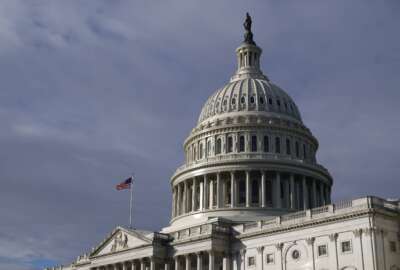First Look
White House details which agencies are ahead, behind on telework goals
Governmentwide, roughly 61% of telework-eligible federal employees' work hours have been in person, according to May 2024 data from the White House.
Editor’s Note: This story was updated with comments from a spokesperson for the House Oversight and Accountability Committee.
After more than a year of pressure building in Congress, lawmakers now have more answers on federal telework levels, return-to-office policies and office space plans from the White House.
In a report the Office of Management and Budget sent to Congress Friday afternoon, shared with Federal News Network, the Biden administration released details on agencies’ varying policies and approaches to where and how federal employees work, as well as federal real estate holdings and plans to improve office space utilization.
While noting that more than half of the federal workforce is not able to telework at all, OMB reported that agencies are on average exceeding the administration’s 50% in-the-office goal for telework-eligible feds. Governmentwide, roughly 61% of the work hours that telework-eligible federal employees performed have been in person, according to time and attendance data OMB collected from the 24 CFO Act agencies during two pay periods in May.
Also based on agencies’ time and attendance data, OMB reported that out of about 2.2 million federal employees:
- About 54% of federal employees worked fully in person due to the nature of their work
- About 46% of federal employees were eligible for telework
- About 10% of federal employees worked fully remotely
“These figures demonstrate that the federal workforce is generally in line with the rates of on-site work performed across all sectors in the economy, as demonstrated by independent analysis from the Congressional Budget Office,” OMB wrote in the report.
OMB’s new report, in response to the near-continuous congressional requests, details current agency-by-agency telework rates and other relevant information from “work environment plans” that many agencies have laid out. OMB collected responses from agencies on how they are currently managing their telework policies, employee performance, property holdings and collective bargaining agreement provisions related to telework.
Of course, OMB’s figures on telework versus in-person work are a governmentwide average. Some agencies had higher in-person rates, while others had lower ones. Based on OMB’s data collection, 15 of the 24 agencies included in the report are exceeding a 50% rate for in-person work hours of telework-eligible employees.
In a more detailed breakdown of the data, OMB’s report showed, for example, that the departments of Agriculture and State had roughly 80% in-person work hours from telework-eligible employees. The departments of Treasury and Education, as well as the Department of Housing and Urban Development, had less than 40% of work hours from telework-eligible employees spent in person.
(Story continues below chart)
2024 rates of in-person work by agency
(Source: Office of Management and Budget 2024 telework report to Congress. Chart created by Federal News Network)
The new OMB report comes in response to a request from Congress in fiscal 2024 appropriations legislation. In March, lawmakers called on OMB to turn over all agencies’ return-to-office “action plans,” which were outlined earlier this year. The new report also comes more than a year after OMB published a memo calling for agencies to strike a more equal balance between telework and in-person work for federal employees following the end of the COVID-19 pandemic.
“That guidance called for agencies to ‘substantially increase meaningful in-person work at federal offices, particularly at headquarters and equivalents,’ while recognizing the diverse operations of federal agencies across the country,” OMB wrote Friday in a blog post accompanying the report.
As a result of the administration’s push, many, but not all, agencies are now largely on track with — if not exceeding — the 50% in-the-office goal that the White House initially laid out in April 2023.
“While no-one-size-fits-all policy can apply universally across the government, federal agencies are moving towards a posture where telework-eligible teams are working in-person at the office at least half of the time, on average,” OMB wrote.
For months, lawmakers have been pushing OMB and all federal agencies for more details on teleworking federal employees. The House Oversight and Accountability Committee has largely taken the lead on pushing for more information on federal telework.
“OMB claims to use data-driven management but has failed to provide evidence to the Oversight committee that justifies major management policies, including widespread, continued federal employee telework,” an Oversight committee spokesman wrote in an email to Federal News Network. “The federal government is the nation’s largest employer and the committee fully expects OMB to provide accurate information on how its policies are efficient, effective and put the American people first.”
Based on multiple studies, OMB said it is leaning in on hybrid work — a mixture of in-person work and telework — because it appears to be the most effective option for improving employee engagement and job satisfaction.
“Emerging research continues to demonstrate the value of in-person work to organizational health and organizational performance, at employers in all sectors but with benefits varying by role and team,” OMB wrote.
OMB also said throughout 2023, it worked with agencies to try to address concerns related to returning to the office — including factors like reopening cafeterias and modernizing workspaces.
“OMB has committed to helping agencies make the necessary changes to strike the right balance and providing support where needed to remove barriers to implementation,” OMB wrote.
Many federal employees, unions and other organizations, however, have maintained that telework options are an important flexibility for recruitment and retention of the federal workforce. In a Federal News Network survey from April, more than two-thirds of respondents said in-office work makes them less productive.
Although most agencies have already created and implemented return-to-office plans, OMB said there is still more work ahead to ensure that all agencies are meeting the goals of the April 2023 memo, particularly the agencies that have not reached the 50% in-the-office goal for telework-eligible employees.
At the same time that agencies are adjusting their balance of telework and in-person work requirements for employees, they’re also considering changes to their real estate and property holdings. Many lawmakers have raised concerns about office space utilization since reports have shown many federal buildings remain underutilized — an issue that predates the pandemic, but that has become a more prevalent concern in recent years.
“Agencies have undertaken considerable work to dispose of unneeded property, reduce costs, and improve overall utilization of real estate,” OMB wrote. “It is important to note that the average age of federal facilities is more than 50 years and older buildings are not efficient or optimally configured for modern work and often require significant modification. Many agencies recognized that they had more office space than needed prior to the pandemic and face continued challenges in right-sizing their real property portfolio.”
But ultimately, OMB said it expects agencies to eventually reach “intentional, competitive and durable work environments.”
Copyright © 2024 Federal News Network. All rights reserved. This website is not intended for users located within the European Economic Area.
Drew Friedman is a workforce, pay and benefits reporter for Federal News Network.
Follow @dfriedmanWFED






